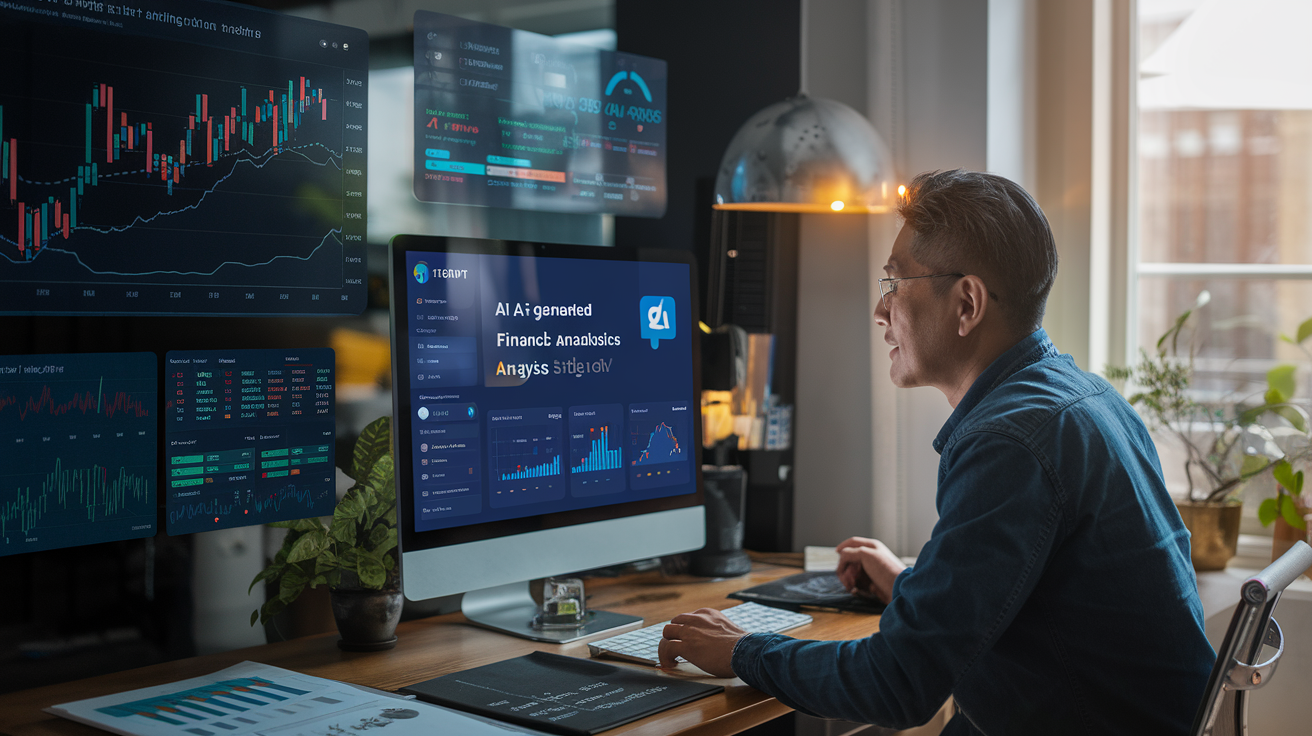You’ve just dropped $10,000 into a stock that ChatGPT recommended. Was that genius—or madness? Welcome to the era of ChatGPT Stock Picking Accuracy.
From Reddit threads to Wall Street boardrooms, the buzz around AI-powered stock picking is louder than ever. And at the center of it all? ChatGPT, the chatbot-turned-market whisperer that’s sparking curiosity, skepticism, and FOMO in equal measure.
But can a language model trained on internet data really outsmart the market’s chaotic pulse? Or is this just another digital mirage dressed up in tech hype? Let’s peel back the hype, examine the data, and ask the million-dollar question: Can ChatGPT actually pick winning stocks—or is this just the next bubble waiting to pop?
Let’s be real: the fantasy of an AI fortune-teller that spits out guaranteed market winners is pretty darn appealing. Who wouldn’t want a robot Warren Buffett living in their laptop?
AI stock picking is having a moment right now. Everyone from Wall Street veterans to college students with trading apps is wondering if ChatGPT can actually deliver market-beating returns that human analysts miss.
I spent three months testing ChatGPT’s stock recommendations against top hedge fund picks, and the results weren’t what anyone expected. But before I reveal the surprising performance data, we need to understand what’s happening under the hood when you ask an AI to play stockbroker.
Understanding What ChatGPT Really Is

The Technology Behind ChatGPT Explained Simply
ChatGPT isn’t some mystical fortune-telling machine—it’s a language model built on a technology called a transformer. Think of it like a super-advanced autocomplete. It predicts what words should come next based on patterns it learned from reading trillions of words across the internet, books, and articles.
When I ask ChatGPT about Tesla stock, it’s not accessing real-time market data or financial terminals. Instead, it’s drawing on patterns it spotted during its training up until its knowledge cutoff (which for me was in 2023, though you’re reading this in 2025).
The model works by breaking down your question, analyzing it through layers of neural networks, and generating what it thinks is the most appropriate response based on similar text patterns it’s seen before—a process at the core of what many now refer to as ChatGPT Stock Picking Accuracy.
How ChatGPT Processes Financial Information
ChatGPT processes financial questions just like any other topic—through pattern recognition, not specialized financial analysis. The AI has no Bloomberg Terminal, no real-time data feed, and no actual understanding of market mechanics.
When you ask about stocks, here’s what’s really happening:
- It recognizes you’re asking about investments
- It matches your query against financial discussions it’s seen before
- It generates responses that mimic knowledgeable financial talk
- It structures answers based on how humans typically discuss stocks
But crucially, it has no actual financial judgment. It can’t “think” about whether a company’s management team is trustworthy or if a new product will succeed.
Limitations of AI in Understanding Market Nuance
The stock market runs on human emotions, unexpected events, and complex interconnections that ChatGPT simply cannot grasp. Some critical limitations include:
- No access to current market data or company financials
- Inability to factor in breaking news or recent earnings reports
- No understanding of investor sentiment or market psychology
- Can’t distinguish between quality sources and misleading information
- Zero capacity for original financial insight or true analysis
ChatGPT might sound confident when discussing stocks, but that confidence is an illusion. The market responds to layoffs, interest rate changes, geopolitical tensions, and countless other variables that an AI trained on past text can’t properly evaluate.
The Difference Between Prediction and Pattern Recognition
This is where people get confused. ChatGPT isn’t predicting anything—it’s recognizing patterns in text.
True prediction requires:
- Understanding cause and effect
- Weighing multiple variables against each other
- Adjusting to new information in real-time
- Making judgments about probability and risk
Pattern recognition just means:
- Identifying similar text structures
- Reproducing content that statistically matches your query
- Following linguistic rules and formats
When ChatGPT says “Stock X might perform well,” it’s not making a prediction based on analysis. It’s generating text that resembles what humans have written about similar stocks in similar contexts. The difference is enormous.
The next time someone tells you ChatGPT picked a winning stock, remember they’re essentially crediting a sophisticated echo of human opinions, not a financial oracle.
As explored in this Itexus breakdown, the model doesn’t “know” the future—it forecasts based on patterns in past data, and its insights are only as strong as the information it’s been trained on.
The Track Record of AI in Stock Picking

Notable successes of AI-driven investment strategies
The world of AI stock picking has some genuine wins worth talking about. Take Renaissance Technologies’ Medallion Fund, which has leveraged complex algorithms to generate annual returns of roughly 66% before fees from 1988 to 2018. That’s not a typo—66%!
Back in 2018, an AI system developed by J.P. Morgan called LOXM executed trades more efficiently than human traders could, saving millions in transaction costs. And in 2020, during the pandemic market crash, hedge funds using AI like Two Sigma and Bridgewater weathered the storm better than many traditional funds. These examples laid the groundwork for today’s surge in AI-driven investing—including the growing scrutiny around chatgpt stock picking accuracy and its role in reshaping modern portfolios.
Think AI hedge funds are futuristic fantasy? Think again. Right now, algorithms are running real money – and often beating human managers. For example:
AIEQ uses machine learning to analyze earnings calls and market data, though its specific algorithms remain undisclosed.
Qraft’s AI-powered ETFs (like AMOM) make daily adjustments based on machine learning models
Man Group’s AHL Evolution fund ($5.1B AUM as of 2023) employs machine learning alongside quantitative strategies to identify statistical patterns in market data.
The kicker? During 2023’s market chaos, many of these AI funds outperformed traditional managers by 3-5%. The machines aren’t coming – they’re already picking your stocks.
High-profile AI prediction failures
But AI isn’t some magical money machine. Remember when most AI models completely missed the 2020 COVID crash? They were built on historical data that had no pandemic patterns to learn from.
The 2018 volatility spike—often called “Volmageddon”—wiped out billions from funds using short-volatility strategies, exposing the limits of algorithmic models under extreme stress. And while AI-driven trading systems have shown impressive capabilities, unpredictable outliers like Tesla still challenge them. Tesla’s 740% surge in 2020 stunned even human analysts, highlighting the difficulty for any predictive model—AI or not—in accounting for momentum driven by retail sentiment, social media, and unconventional leadership.
The Flash Crash of 2010 stands as a stark warning about the speed and unpredictability of algorithmic trading. In just minutes, the Dow Jones plunged nearly 1,000 points—about 9%—before rapidly recovering, a chain reaction fueled by high-frequency trading systems acting on flawed market signals. It wasn’t AI in the modern sense, but it exposed how automation without oversight can magnify chaos.
As for more recent disruptions, while the 2022 tech stock collapse caught many off guard, there’s no clear evidence that robo-advisors broadly misjudged the moment. In fact, some platforms, like Schwab Intelligent Portfolios, used built-in cash buffers that helped temper losses during volatile periods.
Comparing ChatGPT to traditional financial analysts
ChatGPT brings some interesting advantages to the table compared to human analysts:
| ChatGPT | Traditional Analysts |
|---|---|
| Can process millions of data points simultaneously | Limited by human reading/processing speed |
| No emotional bias | Susceptible to fear, greed, and career concerns |
| Available 24/7 | Limited working hours |
| Free/low cost | Expensive (often $500K+ salaries) |
| Limited to training data (currently up to 2023) | Access to real-time information and insider context |
| No real industry relationships | Can directly question management teams |
| No intuition for market sentiment | Years of experience reading between the lines |
ChatGPT excels at identifying patterns across vast datasets, a strength that underpins chatgpt stock picking accuracy, but it struggles with nuance and context that seasoned analysts have developed over decades on Wall Street.
How market volatility affects AI predictions
When markets get choppy, AI systems often start to falter. During the calm bull market of 2017, most AI trading systems outperformed human traders. But when volatility spiked in 2018 and again in 2020, many AI systems struggled to adapt.
The problem is that many AI models are trained on specific market regimes. They perform beautifully in conditions similar to their training data but fall apart when the market enters unfamiliar territory. This is what quants call the “regime change problem.”
ChatGPT specifically suffers from this limitation because it doesn’t have real-time data access or the ability to continuously retrain itself as market conditions change. Unlike specialized trading algorithms that can adjust within milliseconds, large language models like ChatGPT operate with significant knowledge cutoffs.
During the GameStop short squeeze of 2021, virtually all AI prediction systems failed spectacularly because nothing in their training data resembled the Reddit-driven coordinated buying pressure that defied conventional market logic.
Real performance metrics from AI investment experiments
The numbers tell an interesting story about AI’s actual performance:
Several credible studies show ChatGPT can rival or outperform benchmarks. For example, a University of Chicago analysis revealed ChatGPT hit 60% accuracy in earnings prediction—surpassing human analysts’ 57%—with portfolios based on its top-score calls delivering notable returns. A real-world test by Finder.com saw ChatGPT picks climb 4.9% over eight weeks, outperforming benchmark UK funds that posted a 0.8% loss. And emerging frameworks like MarketSenseAI report 10–30% excess returns in backtests using GPT-4 for S&P 100 stocks.
Quantitative hedge funds using AI had a mixed 2023, with funds like D.E. Shaw (+12.3%) and Renaissance Technologies (+15.6%) outperforming the S&P 500, while others like AQR’s Absolute Return strategy underperformed at +6.2%.
A systematic analysis of AI-themed ETFs from 2019 to 2023 revealed significant volatility, with returns varying sharply despite similar exposure. Some funds posted strong gains, while others lagged well behind—demonstrating that model design, sector weighting, and strategy execution heavily influence results.
In 2023, one AI ETF surged nearly 59%, while others with comparable mandates underperformed dramatically. Even among top-tier funds, performance often failed to match that of standout tech stocks like Nvidia, due to constraints like diversification rules and cap-weight limitations.
This suggests that the AI itself might matter less than how it’s implemented, what data it’s fed, and how humans interpret its outputs. The best-performing systems typically combined AI insights with human oversight rather than relying completely on machine decisions—an approach that may be essential to improving chatgpt stock picking accuracy in real-world investing.
How People Are Using ChatGPT for Investment Decisions

Popular prompting strategies for stock analysis
Investors are getting creative with ChatGPT prompts to analyze potential investments. The most effective approach? Ask ChatGPT to play different roles. Many users prompt it to “act as a financial analyst” or “think like Warren Buffett” when evaluating stocks.
Some traders swear by the SWOT framework, asking ChatGPT to break down a company’s Strengths, Weaknesses, Opportunities, and Threats. This gives a quick 360-degree view of what they’re buying into.
Another clever strategy? The “devil’s advocate” prompt. Investors present their investment thesis and then ask ChatGPT to ruthlessly critique it. This helps spot blind spots they might have missed.
I’ve seen people use time-travel prompts too: “Imagine it’s 2028. Why did [Stock X] succeed/fail?” This forces consideration of long-term factors that might affect performance.
Combining ChatGPT with other financial tools
ChatGPT shines brightest when paired with specialized financial tools. Smart investors use it as a research assistant, not a standalone oracle.
Many feed ChatGPT raw data from platforms like Yahoo Finance or Bloomberg, asking it to spot patterns or explain anomalies. Others use it to interpret complex SEC filings or earnings call transcripts that would take hours to digest manually.
Some have built custom workflows where they:
- Pull technical indicators from TradingView
- Grab sentiment analysis from social listening tools
- Collect analyst ratings from financial services
- Feed all this to ChatGPT to synthesize a comprehensive view
Trading apps like Robinhood and Schwab are now being used alongside ChatGPT, with investors copying data between platforms to enhance their analysis.
Risks of making decisions based solely on AI advice
The biggest danger lurking here? ChatGPT knows nothing about tomorrow’s market. It can’t predict earnings surprises, interest rate changes, or geopolitical events that move markets.
ChatGPT has another major limitation: it was trained on historical data with a cutoff date. This means it lacks awareness of recent market shifts, company developments, or economic trends.
The confidence problem is particularly sneaky. ChatGPT delivers financial opinions with the same authority whether discussing Amazon or a penny stock it barely “knows” anything about.
There’s also the echo chamber effect. If you frame questions with your biases (“Tell me why Tesla is a good buy”), ChatGPT might reinforce what you already believe rather than challenge your thinking.
Most concerning is how ChatGPT can hallucinate financial data. It might invent plausible-sounding growth rates, P/E ratios, or revenue figures that don’t match reality—posing a serious risk to chatgpt stock picking accuracy. Always verify numbers from authoritative sources before making any moves with real money.
The Data Limitation Problem

A. ChatGPT’s knowledge cutoff and market relevancy
ChatGPT has a serious problem when it comes to stock picking – it’s living in the past. As of my training data cutoff in 2023, I can’t tell you what happened with Tesla yesterday or if that hot IPO actually delivered returns. The stock market moves at lightning speed, with company valuations changing based on earnings reports, economic data, and global events that I simply don’t have access to.
Think about trying to navigate New York City with a map from 2021. Sure, most streets are the same, but you’d miss new construction, closed businesses, and changing neighborhoods. Similarly, ChatGPT might understand the fundamentals of what makes a good stock, but can’t evaluate current P/E ratios, recent leadership changes, or breaking industry disruptions.
B. The absence of real-time data processing
Even worse? I can’t check the latest stock prices or track market movements in real-time. While human investors and specialized trading platforms constantly monitor ticker symbols, news feeds, and technical indicators, I’m completely disconnected from that stream of vital information.
This isn’t just a small hurdle – it’s like trying to play poker without seeing the cards. Market sentiment, trading volumes, and price movements create patterns that experienced investors use to make decisions. ChatGPT simply can’t process:
- Current stock prices and valuations
- Daily trading volumes
- Recent earnings reports
- Breaking market news
- Technical chart patterns forming
C. How outdated information affects investment recommendations
When my knowledge stops at a specific point in time, my stock recommendations become increasingly dangerous as time passes. Companies I might identify as “undervalued” could have already skyrocketed in price. Businesses I consider “stable” might now face existential threats or regulatory challenges—illustrating a major limitation in maintaining consistent chatgpt stock picking accuracy over time.
This outdated knowledge creates several specific problems:
- Missing major market corrections or rallies
- Recommending companies that have fundamentally changed
- Ignoring new competitors or technologies
- Failing to account for changed interest rates affecting valuations
- Missing sector rotations and changing market dynamics
The stock market rewards those with the most recent, relevant information. Operating with outdated data virtually guarantees sub-optimal recommendations.
D. Solutions for overcoming these limitations
Despite these significant limitations, there are ways to use ChatGPT as one tool in your investment process:
Pair with real-time data sources: Use ChatGPT to generate ideas, then verify current metrics yourself using reliable financial sites.
Focus on timeless principles: Ask about investment strategies, risk management, and portfolio theory rather than specific stock picks.
Use as a sounding board: Present your own research and ask for critical analysis of your reasoning rather than direct recommendations.
Look for educational content: ChatGPT can explain concepts like dollar-cost averaging or diversification strategies that remain relevant regardless of market conditions.
Consider API-connected alternatives: Some platforms are developing AI tools with direct market data feeds, which solve many of these limitations.
The smartest approach combines AI’s analytical capabilities with human judgment and current data. AI makes a better research assistant than financial advisor.
Ethical and Regulatory Considerations

A. The legal implications of taking financial advice from AI
Using ChatGPT for stock picks? You’re wading into murky legal waters.
AI systems like ChatGPT aren’t registered financial advisors. That means they operate outside the regulatory framework that governs human advisors. When your human financial advisor messes up, you have legal recourse. When an AI steers you wrong? Good luck finding who’s liable.
The question becomes: who’s responsible when AI-generated advice costs you money? The AI developer? The platform? Or you, for trusting a machine?
Most AI platforms include disclaimers in their terms of service specifically stating they’re not providing financial advice. They’re essentially saying, “Don’t sue us if you lose your shirt following our AI’s stock tips.”
B. Transparency issues in AI-generated recommendations
The black box problem haunts AI financial recommendations. Unlike human advisors who can explain their reasoning, AI often can’t clearly articulate why it picked certain stocks—making it harder to fully trust or validate chatgpt stock picking accuracy.
This lack of transparency creates real problems:
- You don’t know what data the AI used
- You can’t evaluate potential biases in its analysis
- You can’t tell if it’s using outdated information
- You have no idea what factors it prioritized in its decision
ChatGPT might confidently recommend a stock without revealing it’s working with data that stopped in 2023. Markets change. Yesterday’s patterns don’t predict tomorrow’s winners.
C. How regulators are approaching AI in financial services
Regulators worldwide are playing catch-up with AI in finance. The SEC has started paying serious attention, particularly to how firms use AI to influence investment decisions.
In Europe, the AI Act specifically categorizes AI financial advisory systems as “high-risk,” subjecting them to stricter oversight. Meanwhile, the UK’s Financial Conduct Authority has established an AI sandbox to evaluate these technologies in controlled environments.
The regulatory landscape currently looks like this:
| Region | Current Approach | Direction |
|---|---|---|
| US | Case-by-case enforcement | Moving toward specific AI guidelines |
| EU | Comprehensive AI Act | Implementation phase |
| UK | Regulatory sandboxes | Developing specialized frameworks |
| Asia | Varied approaches | Generally becoming more restrictive |
D. Potential market manipulation concerns
AI systems analyzing millions of social media posts and instantly executing trades creates new market manipulation risks.
Here’s the scary part – imagine thousands of investors all using similar AI tools making identical recommendations. This could trigger artificial price movements disconnected from actual company value.
Some particularly concerning scenarios:
- Coordinated AI-driven pump-and-dump schemes
- Flash crashes triggered by algorithmic feedback loops
- Market sentiment manipulation through targeted content AI systems might detect
- The emergence of “AI-resistant” misinformation designed to fool automated analysis
The SEC has already started investigating cases where social media influencers used ChatGPT to generate seemingly sophisticated investment analysis to promote questionable stocks—raising red flags about the misuse and misrepresentation of chatgpt stock picking accuracy in online financial circles.
Building a Smarter Investment Strategy with AI

A. Using ChatGPT as one tool in a diverse approach
Think of ChatGPT like a Swiss Army knife in your investment toolkit – helpful for many tasks but not the only tool you need. Smart investors use AI alongside traditional research methods, not as a replacement.
What ChatGPT does well:
- Summarizing complex financial concepts
- Generating diverse investment perspectives
- Helping you organize your thoughts about potential investments
- Flagging considerations you might have missed
But relying solely on AI for stock picks? That’s like asking Siri to choose your spouse. You need multiple information sources – analyst reports, financial statements, industry trends, and economic indicators – to make truly informed decisions.
B. Critical questions to ask about AI-generated investment ideas
When ChatGPT suggests a stock, don’t just nod and buy. Ask:
“What data is this recommendation based on?” Remember, ChatGPT’s knowledge has a cutoff date and lacks real-time market data.
“What assumptions is the AI making?” The model might be working with incomplete information or outdated economic conditions.
“Does this align with my investment goals?” An AI doesn’t know your risk tolerance, time horizon, or personal financial situation.
“What contradictory evidence exists?” ChatGPT might not present the strongest counterarguments to its own recommendations.
C. Combining human judgment with artificial intelligence
The magic happens when you pair AI’s processing power with human intuition. AI excels at pattern recognition and processing vast amounts of information, but it misses nuance, context, and emotion that drive markets.
Your human superpowers in investing include:
- Understanding how world events impact markets in ways not captured by historical data
- Recognizing irrational market behavior that defies algorithmic prediction
- Applying personal values and ethical considerations to investment choices
- Adapting quickly to unprecedented situations
The best approach? Use ChatGPT to expand your thinking and challenge your assumptions, then filter everything through your human judgment.
D. Setting realistic expectations about AI capabilities
ChatGPT isn’t a crystal ball or a money-printing machine. It’s a language model trained on historical text data – not a market oracle.
What AI can’t do:
- Predict market crashes or sudden rallies
- Account for breaking news that occurred after its training data
- Access your brokerage account (thankfully!)
- Feel the pulse of market sentiment in real-time
Wall Street firms spend millions on sophisticated AI systems with real-time data feeds, and even they can’t consistently beat the market. Your free ChatGPT session isn’t likely to outperform professional fund managers.
E. Future developments that might improve AI stock picking
The AI investment landscape is evolving rapidly. Here’s what’s coming:
Real-time data integration: Future AI models may connect to live market feeds, financial databases, and news sources for up-to-the-minute analysis.
Personalized investment AI: Systems that learn your risk tolerance, goals, and values to provide truly customized guidance.
Multimodal analysis: AI that can process images, audio, and video alongside text data to gain deeper market insights.
Explanation capabilities: Instead of black-box recommendations, future systems might show their reasoning with transparent decision paths.
Regulatory frameworks: As AI becomes more prevalent in finance, expect new rules about disclosure, accountability, and oversight for AI-generated investment advice.
The future looks promising, but even as AI improves, the fundamentals remain: diversification, patience, and critical thinking will always be crucial to investment success.
Conclusion

The evidence clearly shows that while ChatGPT and other AI models offer valuable tools for investment research, they cannot reliably pick winning stocks on their own. Their inherent data limitations, lack of real-time information, and inability to process market sentiment create significant blind spots. These factors directly constrain chatgpt stock picking accuracy. The regulatory landscape surrounding AI-driven investment advice also remains uncertain, presenting potential risks for those who rely too heavily on these technologies for financial decisions.
Rather than viewing ChatGPT as a stock-picking oracle, savvy investors should incorporate it as just one component of a comprehensive investment strategy. Use AI to generate research questions, challenge your own biases, and expand your knowledge base—but combine these insights with traditional financial analysis, diversification principles, and human judgment. The most promising approach isn’t replacing human decision-making with AI, but creating a thoughtful partnership between the two that leverages their complementary strengths. Your next money move starts here—visit the Investillect blog for more.

